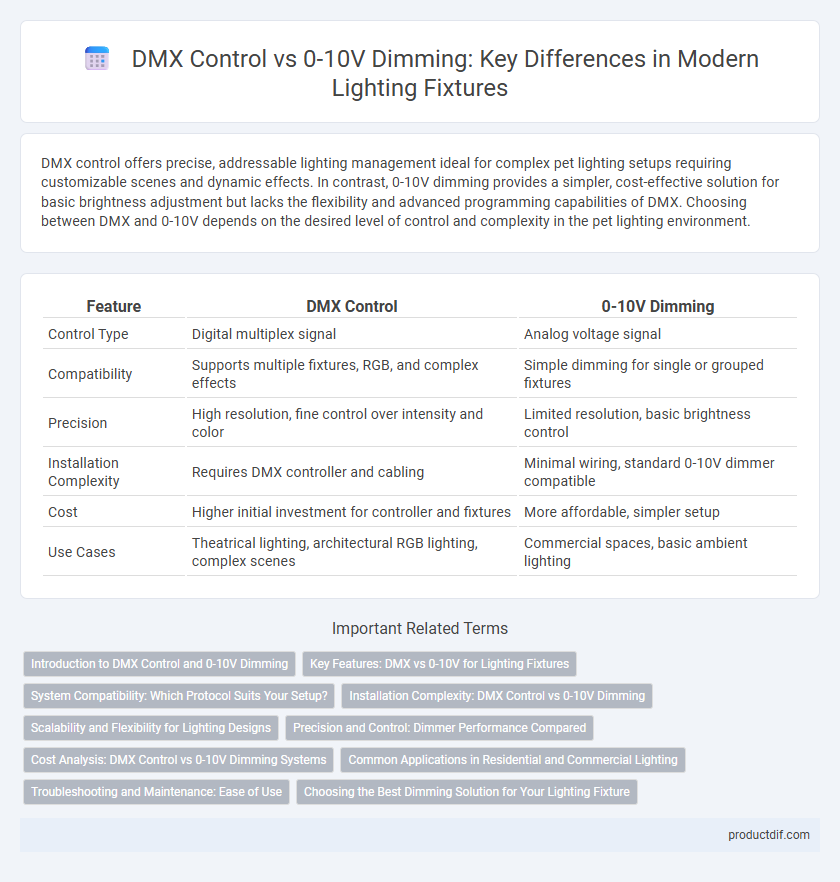DMX control offers precise, addressable lighting management ideal for complex pet lighting setups requiring customizable scenes and dynamic effects. In contrast, 0-10V dimming provides a simpler, cost-effective solution for basic brightness adjustment but lacks the flexibility and advanced programming capabilities of DMX. Choosing between DMX and 0-10V depends on the desired level of control and complexity in the pet lighting environment.
Table of Comparison
| Feature | DMX Control | 0-10V Dimming |
|---|---|---|
| Control Type | Digital multiplex signal | Analog voltage signal |
| Compatibility | Supports multiple fixtures, RGB, and complex effects | Simple dimming for single or grouped fixtures |
| Precision | High resolution, fine control over intensity and color | Limited resolution, basic brightness control |
| Installation Complexity | Requires DMX controller and cabling | Minimal wiring, standard 0-10V dimmer compatible |
| Cost | Higher initial investment for controller and fixtures | More affordable, simpler setup |
| Use Cases | Theatrical lighting, architectural RGB lighting, complex scenes | Commercial spaces, basic ambient lighting |
Introduction to DMX Control and 0-10V Dimming
DMX control uses a digital protocol enabling precise, multi-channel lighting management, making it ideal for complex stage and architectural lighting systems. In contrast, 0-10V dimming relies on an analog voltage signal to adjust light intensity, offering straightforward installation and compatibility with standard commercial fixtures. Understanding these core differences helps optimize lighting design for specific applications and user requirements.
Key Features: DMX vs 0-10V for Lighting Fixtures
DMX control offers precise, multi-channel lighting management ideal for complex stage and architectural lighting setups, enabling individual fixture addressing and dynamic scene creation. 0-10V dimming provides a simpler, cost-effective solution suitable for basic dimming needs with standard analog signals controlling brightness levels between 0 and 10 volts. DMX systems support extensive automation and real-time adjustments, while 0-10V dimming is limited to single-parameter control and less flexible integration.
System Compatibility: Which Protocol Suits Your Setup?
DMX control offers extensive compatibility with professional lighting consoles and complex stage setups, supporting multiple channels for intricate lighting effects. In contrast, 0-10V dimming excels in simpler installations, such as architectural lighting, due to its straightforward analog signal and broad compatibility with standard dimmers. Choosing the right protocol depends on your system's scalability, control precision, and existing infrastructure requirements.
Installation Complexity: DMX Control vs 0-10V Dimming
DMX control systems require more intricate wiring and configuration, involving multiple data lines and addressing for each lighting fixture, increasing installation complexity. In contrast, 0-10V dimming uses simpler two-wire analog control signals, making it easier and faster to install with fewer points of failure. The choice impacts labor costs and time, with DMX demanding specialized knowledge for programming and troubleshooting compared to the straightforward voltage-based approach of 0-10V dimming.
Scalability and Flexibility for Lighting Designs
DMX control offers superior scalability and flexibility for lighting designs by enabling precise, individual fixture management across extensive setups, ideal for complex architectural or stage lighting. In contrast, 0-10V dimming is simpler and cost-effective but limited in scalability, as it typically supports fewer channels and less granular control. For dynamic, large-scale environments requiring customizable scenes and synchronized effects, DMX remains the industry standard.
Precision and Control: Dimmer Performance Compared
DMX control offers superior precision and flexibility in lighting fixture dimming compared to 0-10V dimming by allowing addressable control of individual fixtures with 256 or more intensity levels per channel. This digital protocol enables seamless integration with complex lighting setups and real-time adjustments through standardized DMX512 signals, providing greater accuracy and consistency in dimmer performance. In contrast, 0-10V dimming relies on analog voltage signals with limited resolution and potential signal degradation over long cable runs, resulting in less precise control and reduced dimming smoothness.
Cost Analysis: DMX Control vs 0-10V Dimming Systems
DMX control systems often entail higher initial costs due to advanced digital technology and complex installation requirements compared to 0-10V dimming systems, which are typically more affordable and simpler to implement. Maintenance and scalability expenses also differ, with DMX offering greater flexibility for large, intricate lighting setups, potentially reducing long-term operational costs despite upfront investments. Analyzing total cost of ownership reveals that 0-10V systems suit smaller projects with budget constraints, while DMX systems justify their expense through enhanced control, integration capabilities, and future-proofing benefits in extensive lighting installations.
Common Applications in Residential and Commercial Lighting
DMX control is widely used in commercial lighting setups such as theaters, clubs, and large venues for precise, programmable multi-channel lighting effects, while 0-10V dimming is common in residential and office buildings due to its simplicity and compatibility with standard dimmers. DMX systems excel in dynamic environments requiring synchronized color changes and complex scenes, whereas 0-10V dimming provides reliable, energy-efficient lighting adjustments in fixed, ambient lighting applications. Both systems support LED fixtures, but 0-10V remains prevalent in spaces prioritizing straightforward, cost-effective light level control over elaborate programming.
Troubleshooting and Maintenance: Ease of Use
DMX control systems offer precise control and real-time troubleshooting capabilities through digital addressing and feedback, simplifying complex lighting setups and fault detection. In contrast, 0-10V dimming is easier to maintain due to its straightforward analog wiring and fewer components, but it lacks advanced diagnostics for pinpointing issues quickly. Choosing between them depends on the need for detailed control versus simplicity in maintenance and troubleshooting workflows.
Choosing the Best Dimming Solution for Your Lighting Fixture
DMX control offers precise, customizable lighting effects with seamless integration for complex setups, making it ideal for professional stage and architectural lighting fixtures. In contrast, 0-10V dimming provides a simple, cost-effective solution suitable for standard commercial and residential applications requiring basic dimming functionality. Selecting the best dimming solution depends on the fixture's intended use, control system compatibility, and the desired level of lighting precision and programmability.
DMX Control vs 0-10V Dimming Infographic

 productdif.com
productdif.com